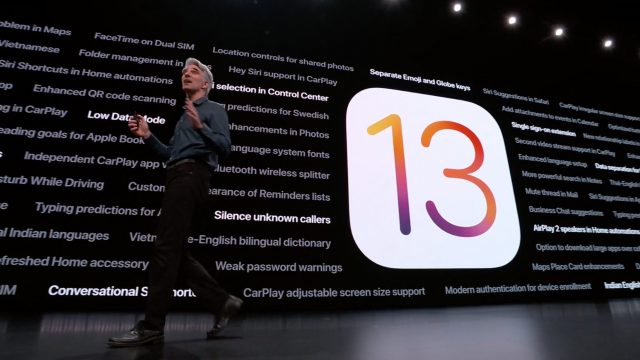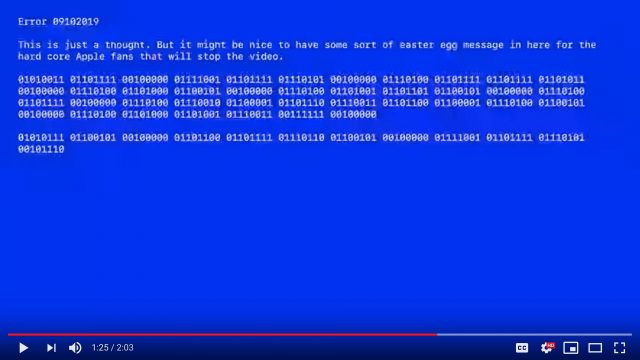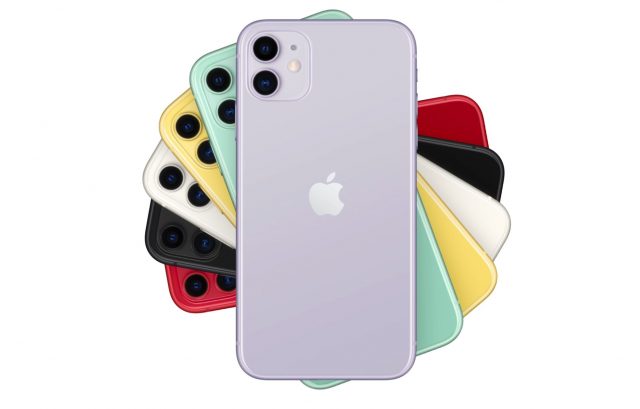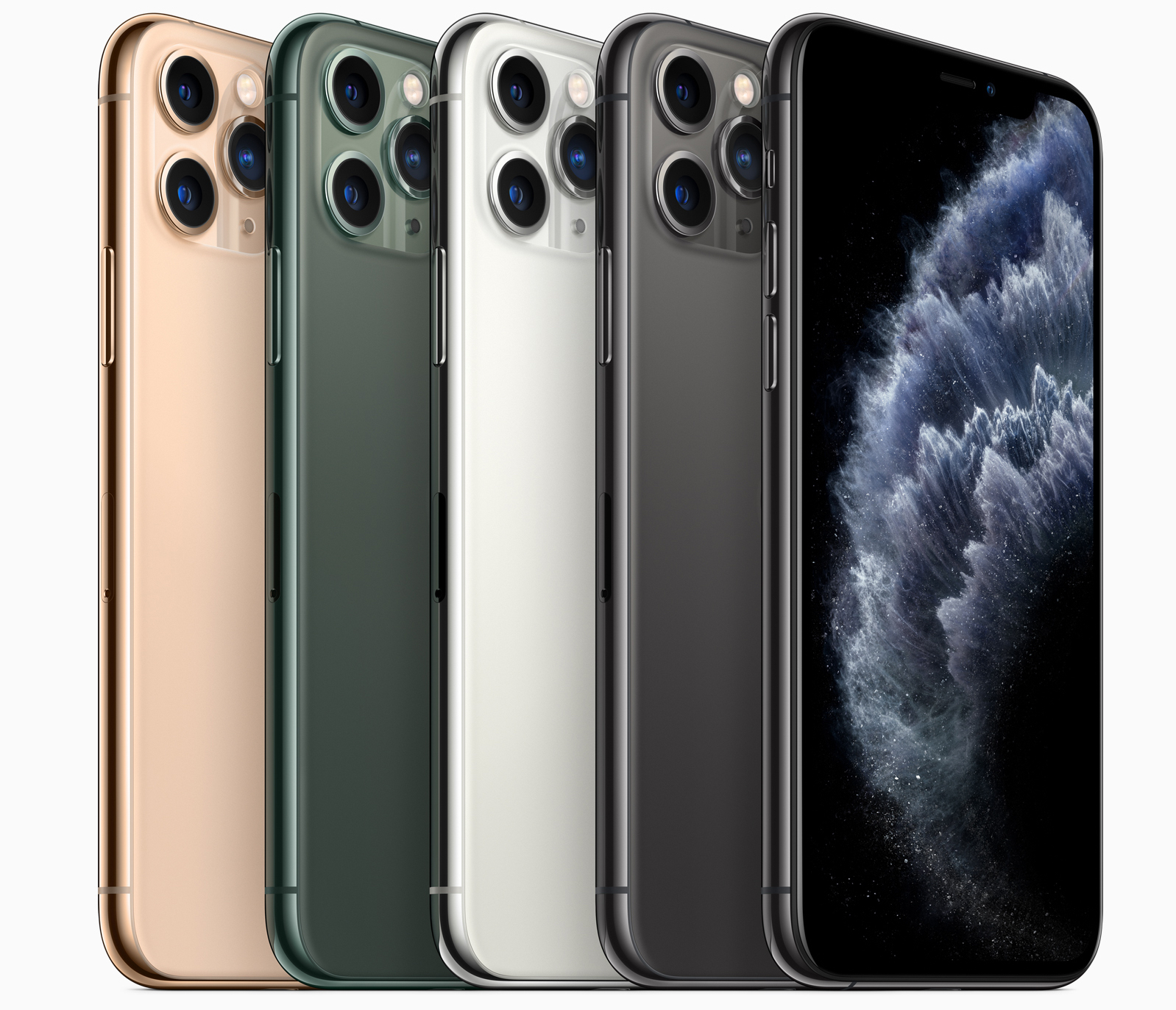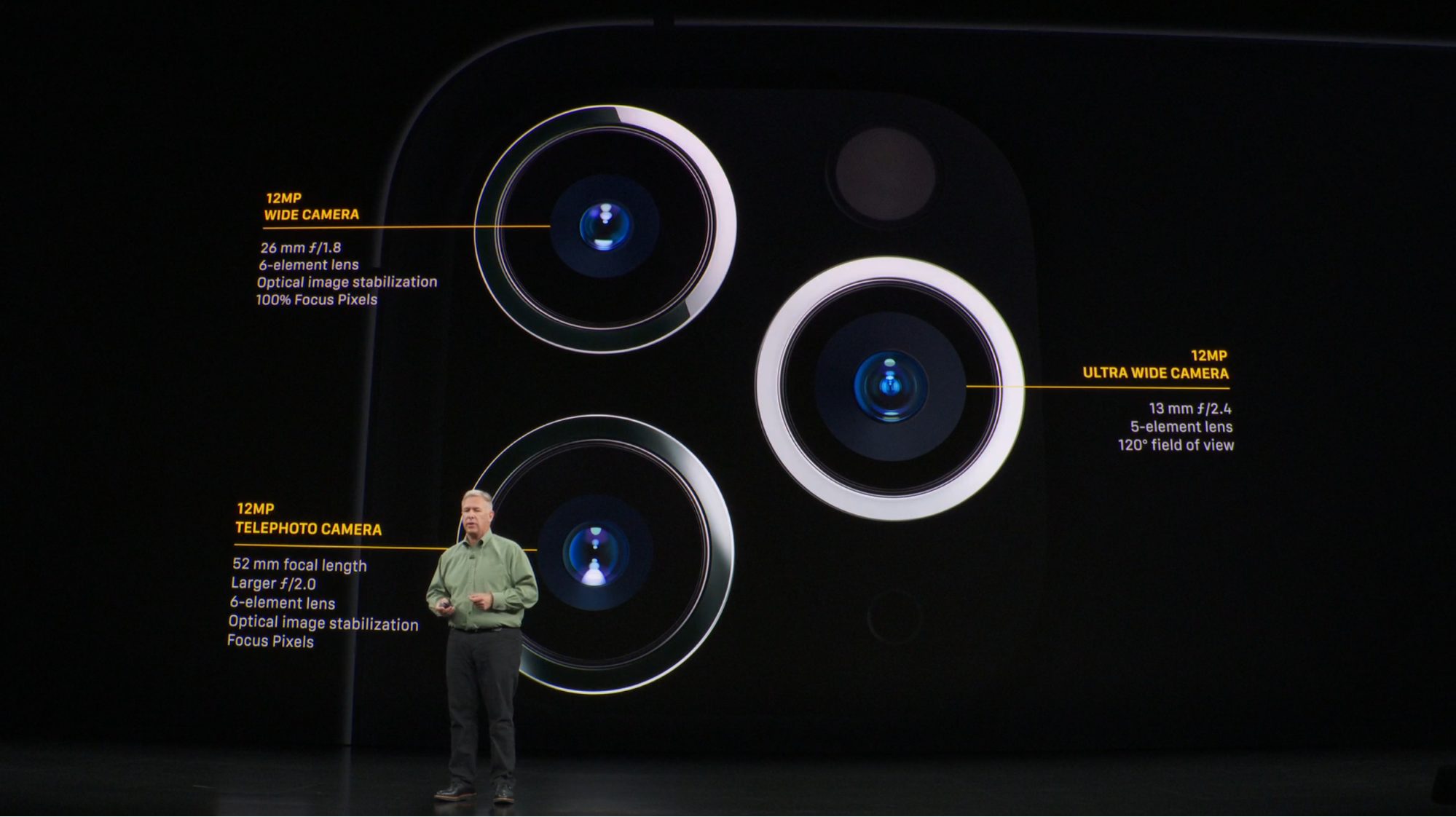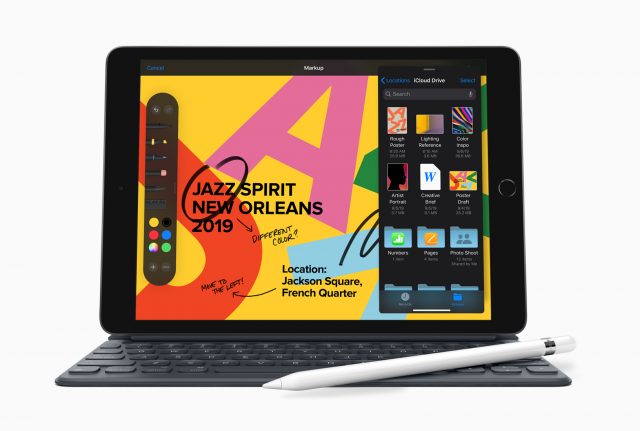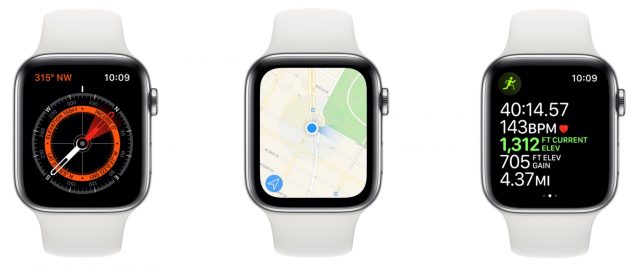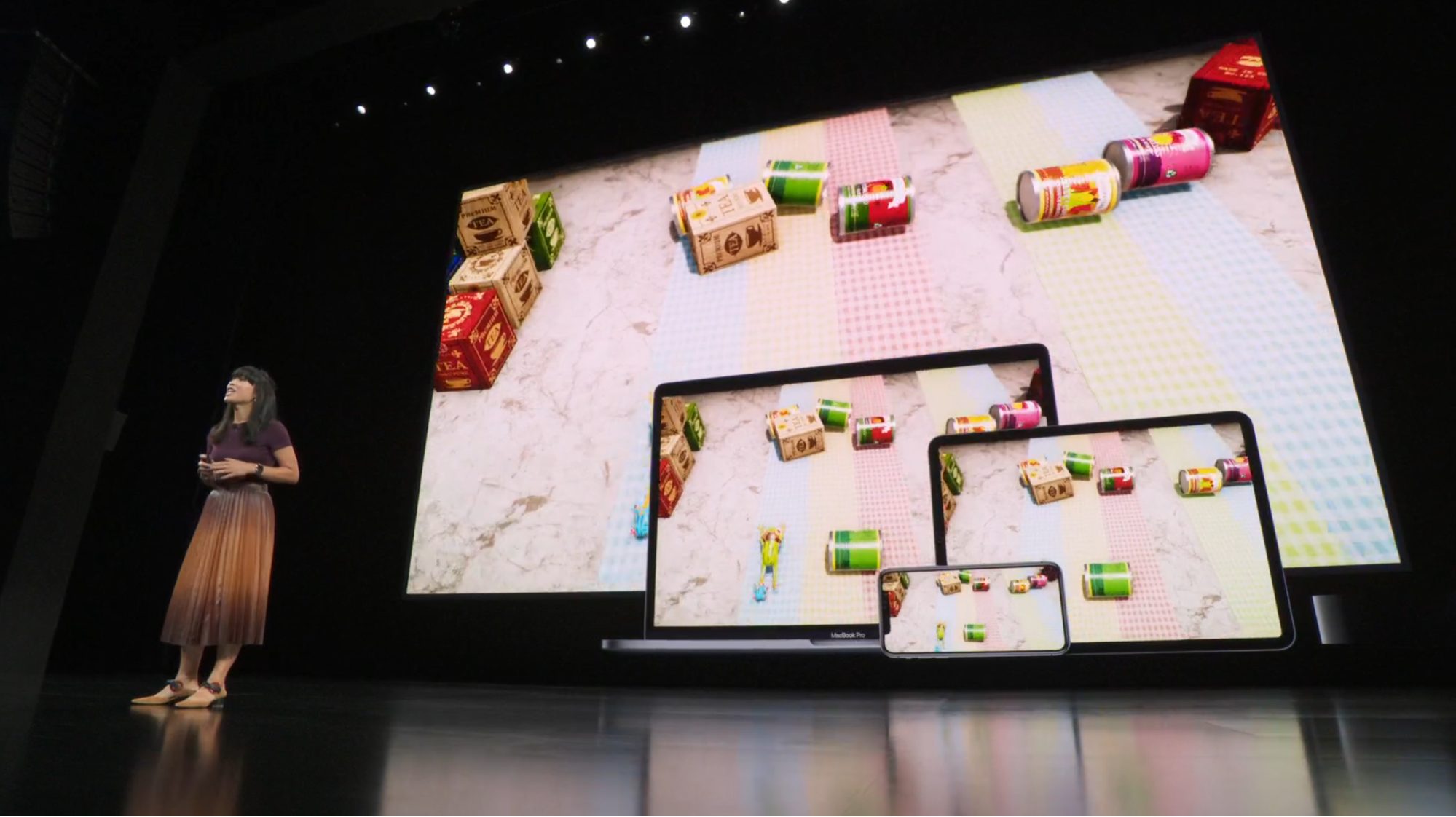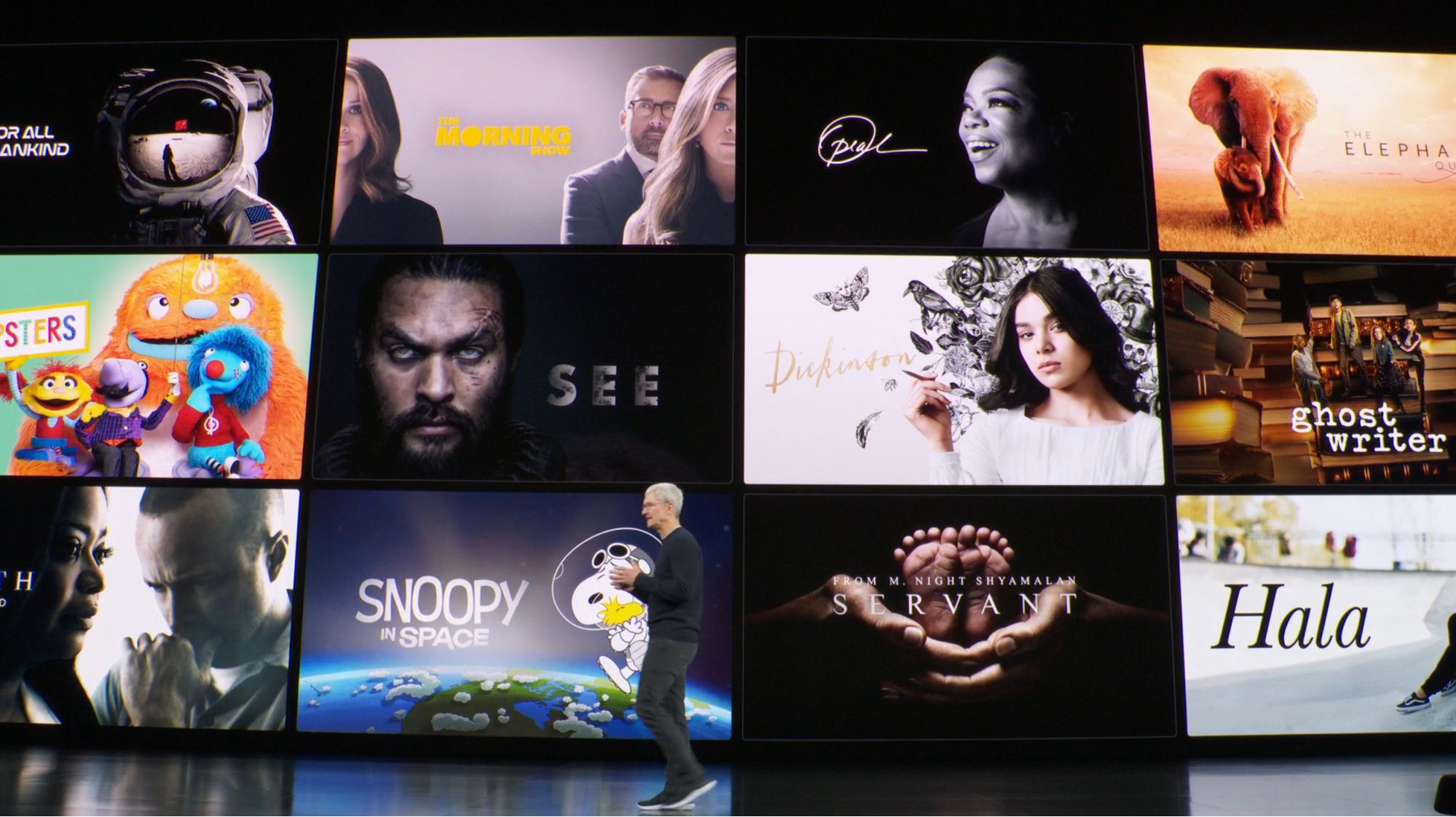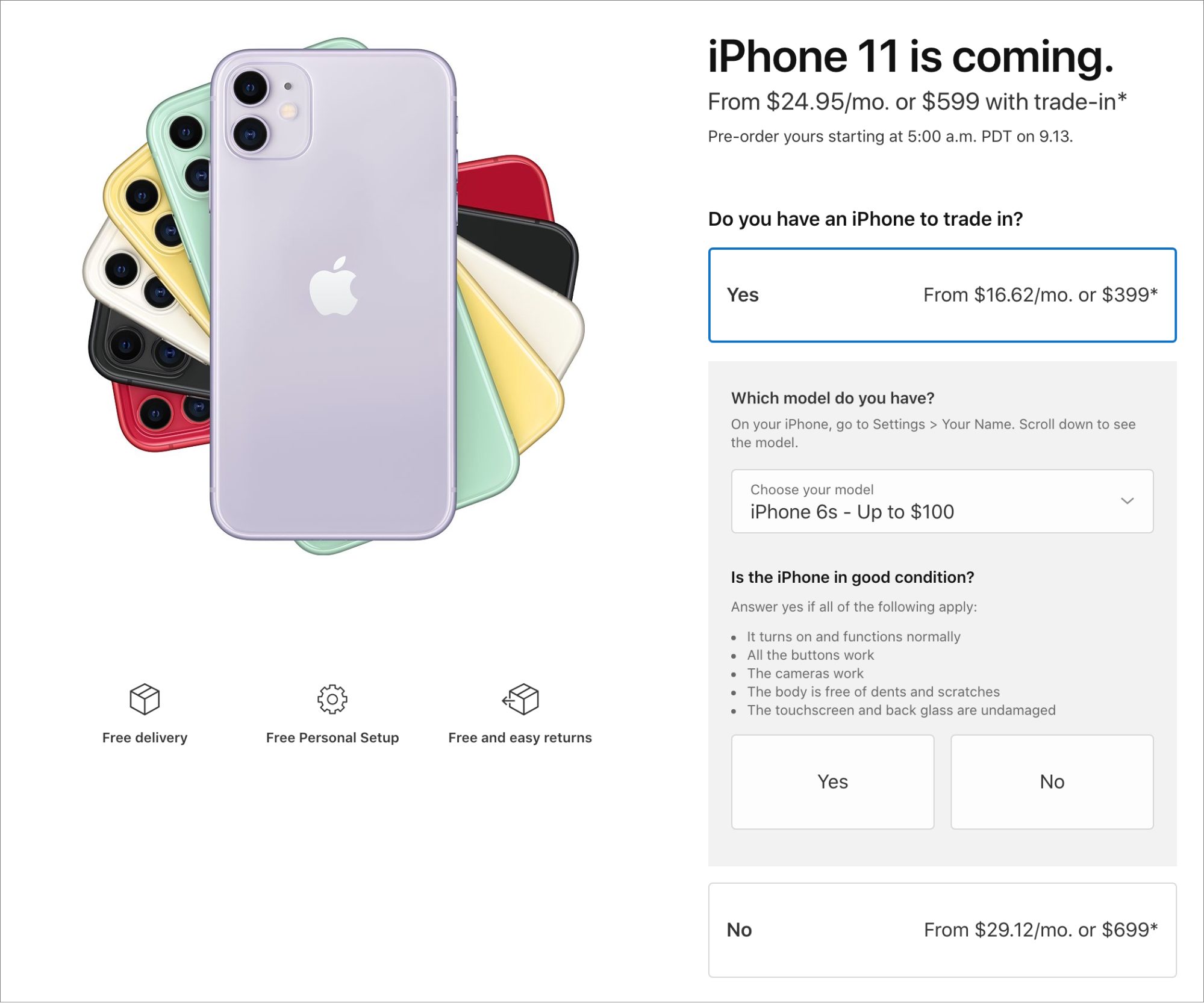#1482: iOS 13 launch date, Apple event video Easter egg, iPhone 11 and 11 Pro, 7th-gen iPad, Apple Watch Series 5, Apple Arcade and TV+, iPhone purchase options
Did you watch Apple’s special event last week, where the company announced the iPhone 11, iPhone 11 Pro, and iPhone 11 Pro Max; the new seventh-generation iPad; and the Apple Watch Series 5 with an always-on screen? We have details of each announcement for you, and Apple has also posted a 2-minute supercut video of the event, complete with an Easter egg. If you’re planning to pick up a new iPhone 11 but haven’t already placed your pre-order, Josh Centers outlines all the different ways you can pay for a new iPhone. Finally, even if you don’t plan to buy anything new, read on to discover Apple’s upcoming ship dates—starting September 19th—for iOS 13, iOS 13.1, iPadOS 13, watchOS 6, macOS 10.15 Catalina, Apple Arcade, and Apple TV+. Notable Mac app releases this week include Cyberduck 7.1, Transmit 5.6, DEVONthink 3.0, BBEdit 12.6.7, Quicken 2019 5.12.4, BusyCal 3.7 and BusyContacts 1.4.1, and Bookends 13.2.6.
Apple to Ship iOS 13 on September 19th, iOS 13.1 on September 30th
Traditionally, Apple reveals the ship dates for its upcoming operating systems during its September special event. This year, however, those dates weren’t mentioned during the presentation and only trickled out quietly afterward.
iOS 13.0 will become available on September 19th, the day before the new iPhones arrive in customers’ hands with iOS 13 installed. But don’t get too attached to that version, because Apple also said that iOS 13.1, which adds back several features that the company pulled from the betas of iOS 13, will ship just 11 days later, on September 30th.
Although iPadOS is a superset of iOS 13, Apple is holding it until September 30th, presumably to coincide with the release date of the new iPads. We suspect that we’ll get iPadOS 13.1 on that date.
The company also said that watchOS 6 will hit the Internet on September 19th alongside iOS 13. That makes sense, given how tightly tied it is to iOS 13. And it matches with the ship date for the Apple Watch Series 5.
What about tvOS 13? Again, September 19th seems the most likely, just because Apple likes to pump everything out at once, but no external factors provide any other hints.
And for the $64,000 question, when will macOS 10.15 Catalina appear? Not on September 19th, or in September at all. All Apple has said is that we can expect it sometime in October. As such, if you upgrade to iOS 13, you’ll want to hold off on upgrading your Reminders database to take advantage of the new features, since those won’t sync with 10.14 Mojave. (Tap Upgrade Later when prompted by Reminders in iOS 13.)
Apple Embeds Easter Egg in iPhone 11 Event Supercut Video
Apple’s September 10th event took 102 minutes, and if you missed it live, you can watch it in its entirety. We instead recommend the 2-minute summary that Apple has now posted on YouTube.
https://www.youtube.com/watch?v=ZA3MV2V–TU
It’s fast, frenetic, and lets you skip watching not one, not two, but three demos in which some dude plays a new Apple Arcade game while some other dude tells you just how impressive it is, just like every Apple event game demo ever (except for the third demo, where some dude plays the game while a woman tells you how impressive the game is). That might have been when our SlackBITS discussion turned to the Apple executives’ wardrobe choices.
The best part of the supercut video comes at 1:25. Just after the narrator hammers home Apple’s marketing point that the seventh-generation iPad is two times faster than the best-selling PC laptop, there’s a brief glitch with an entirely visible blue screen. Pause the video at that point and you’ll see a dig at the Windows Blue Screen of Death with an error code referencing the event date and a message saying:
This is just a thought. But it might be nice to have some sort of easter egg message in here for the hard core Apple fans that will stop the video.
After the message comes a bunch of binary, which TechCrunch ran through a binary-to-ASCII converter to decode into:
So you took the time to translate this? We love you.
It’s such a joy to see Apple showing a sense of humor in this way, though to be fair, the videos the company creates to introduce its special events are often fairly amusing. Nevertheless, such tomfoolery makes me long for the days when Apple engineers managed to sneak Easter eggs into apps and the operating system (for more on that, see “James Thomson Presents an Illustrated History of Easter Eggs,” 24 July 2019). There’s something about having to figure out the steps for a software Easter egg that implies “we’re all in this together” and gives the software—and its corporate puppetmaster—a human touch beyond what a few funny frames in a video can achieve.
Apple Announces iPhone 11, iPhone 11 Pro, and iPhone 11 Pro Max
Apple has three new iPhones for its 2019 lineup: the iPhone 11, iPhone 11 Pro, and iPhone 11 Pro Max. All three became available for pre-order on 13 September 2019 at 5 AM PDT (note the different time than in years past!) and will arrive in stores and in customers’ hands starting on 20 September 2019.
Although rumors continue to swirl about Apple introducing a new low-cost “iPhone SE 2” next year, the iPhone 11 is cheaper than last year’s “budget” iPhone XR model, starting at $699 for 64 GB of storage, down from the $749 iPhone XR starting price. The iPhone 11 Pro starts at $999 with 64 GB of storage, the same as last year’s iPhone XS. The iPhone 11 Pro Max starts at $1099, which is also the same as the iPhone XS Max.
All three models sport additional cameras over their 2018 counterparts and promise significantly enhanced options for photos and videos. In fact, Apple attributed the “Pro” part of the iPhone 11 Pro name to the capabilities made possible by those phones’ triple-camera approach. (“Max” still means “larger than fits the average pocket.”)
Notably missing from all three models is 3D Touch, which has been replaced by Haptic Touch. It offers 3D Touch’s haptic feedback but doesn’t let you press in on the screen to access more options. iOS 13 has largely made 3D Touch irrelevant anyway, given that you can now tap and hold on items to get the contextual options that were previously exclusive to 3D Touch.
Despite wishes on the part of some people that Apple would switch from Lightning to USB-C, this year’s iPhones still have Lightning ports. However, the included USB cable is now a Lightning-to-USB-C cable instead of Lightning-to-USB-A.
Let’s take a look at the details of each new phone.
iPhone 11
If you hate the notch first introduced with the iPhone X, we’re sorry to disappoint, but it’s still present in the iPhone 11, aimed at the everyday iPhone user. But there are two things you will notice right away. There are new color options: purple, green, yellow, white, black, and Product(RED). The first three colors are more in the Easter egg pastel palette than previous iPhone colors. You’ll also notice a second camera on the back of the iPhone 11, a feature previously exclusive to the higher-end iPhones.
The iPhone 11 comes with a 6.1-inch Liquid Retina LCD display, with 1792‑by‑828‑pixel resolution at 326 ppi, 1400:1 contrast ratio, and 625 nits of brightness. That’s the same as last year’s iPhone XR. Also identical to the iPhone XR are the iPhone 11’s dimensions, so if you were hoping for something more likely to fit in your pocket, sorry.
Here’s a summary of what’s new with the iPhone 11:
- A13 Bionic: New year, new processor. Apple promises that the A13 Bionic is up to 20% faster than the A12 and uses 40% less power.
- Wide and Ultra Wide camera modes: The second camera allows for a new ultra-wide mode, which lets you zoom out as well as in. You can use both modes while capturing 4K video, as well as still photography.

- Night mode: The second camera also enables the new Night mode that, like the Night Sight feature in Google’s Pixel phones, lets you take vastly improved low-light shots by combining multiple images taken at different exposures.

- Smart HDR and Deep Fusion: Apple touts a “next-generation” Smart HDR feature that uses machine learning to improve High Dynamic Range photography, which also combines multiple images at different exposures. Later this year, an iOS update will enable a new Deep Fusion feature, which uses machine learning to improve photo quality even further.
- QuickTake: You can already take a still photo while recording a video, but QuickTake lets you do the reverse. When in Photo mode, press and hold the shutter button to start recording a video quickly. You can also swipe right to switch into Video mode completely or swipe left for Burst mode.
- 4K and slo-mo selfies: Narcissists rejoice! The front-facing TrueDepth camera can now capture 4K video at 60 frames per second, as well as slow-motion video, for which Apple has coined the repulsive word “slofies.” Remember, thanks to 4K video, we can see your nose hair.
- Faster Face ID: Rumors of Touch ID’s return didn’t pan out, but Apple claims that Face ID is now 30% faster and works at wider angles.
- Spatial audio: The iPhone 11 features spatial audio, a technology borrowed from the HomePod that emulates surround sound. We’re curious to see how it works in the real world. The iPhone 11 also supports Dolby Atmos audio, which could provide some improvements in movies that support it. We doubt most TidBITS readers watch many movies on their iPhones, so they won’t care much about either.
- Faster networking: No 5G this year, but the iPhone 11 supports “gigabit-class” LTE and the Wi-Fi 6 networking protocol (see “Wi-Fi Switches from Obscure Protocol Names to Simple Generation Numbers,” 5 October 2018).
- The Mysterious U1 Chip: Briefly mentioned at the event, but not discussed, was the new U1 chip. Apple’s press release says: “The new Apple-designed U1 chip uses Ultra Wideband technology, the first ever in a smartphone, for spatial awareness. With iOS 13.1 coming on September 30, AirDrop gets even better with directionally aware suggestions.” We still don’t know what it does. It may be related to a rumored “Apple Tag” product that could help you find lost items like keys and Apple TV remotes. Jason Snell has more about it on Six Colors.
- Longer battery life: Apple claims the iPhone 11 has up to 1 hour longer battery life than the iPhone XR.
Here’s what you’ll pay for each storage tier of the iPhone 11:
- 64 GB: $699
- 128 GB: $749
- 256 GB: $849
Apple also announced an updated trade-in program that could cut your purchase price substantially.
iPhone 11 Pro and iPhone 11 Pro Max
What makes the iPhone 11 Pro a pro device? For one, it sports a stainless steel case instead of aluminum and a different set of more conservative color options: gold, midnight green, silver, and space gray.
But the real reason for the “Pro” moniker is the third camera on the back of the iPhone 11 Pro, which allows for a Telephoto mode in addition to the Wide, Ultra Wide, and Night modes offered by the iPhone 11. Apple showed off some impressive photography and videography made possible by the new cameras, and we’re looking forward to independent reviews once the iPhone Pro becomes available.
Along with the camera improvements, the iPhone 11 Pro offers a fancy display to match: the OLED-powered Super Retina XDR display, which Apple is marketing as being a miniature version of the company’s upcoming $5000 Mac Pro display. The iPhone 11 Pro offers a 5.8-inch screen with 2436-by-1125-pixel resolution at 458 pixels per inch while the iPhone 11 Pro Max features a 6.5-inch display with 2688-by-1242-pixel resolution at 458 ppi. Both screens put out up to 1200 nits of brightness with a 2,000,000:1 contrast ratio.
Perhaps the most impressive camera feature Apple demonstrated was an upcoming version of FiLMiC Pro that allows recording 4K video at 60 frames per second from multiple iPhone 11 Pro cameras at the same time. If you plan to do that, we’re guessing that you’ll want to spring for the 512 GB model.
Apple touts significant battery life improvements in the Pro models over last year’s XS line: up to 4 hours more than the iPhone XS and 5 hours more than the iPhone XS Max.
Here’s the pricing for the iPhone 11 Pro:
- 64 GB: $999
- 256 GB: $1149
- 512 GB: $1349
And the iPhone 11 Pro Max:
- 64 GB: $1099
- 256 GB: $1249
- 512 GB: $1449
Which iPhone to Choose?
If you’re looking to buy a new iPhone this year, you have a pretty simple choice. Most people will be more than happy with the iPhone 11, which comes at a reasonable price and has most of the iPhone 11 Pro’s features. But if you’re a serious photographer or videographer, the iPhone 11 Pro is a no-brainer—it truly earns its “Pro” name. And if your pockets are deep enough (both financially and physically), the iPhone 11 Pro Max provides the same level of photographic power with a notably larger screen.
If the new features don’t excite you, or your budget cringes at the cost, the iPhone 8 and iPhone XR remain for sale, starting at $449 and $599, respectively.
Apple’s Base Model iPad Goes Semi-Pro
I’ve long said that Apple’s base-model iPad is the best value in the company’s entire lineup, and that will be even more true on 30 September 2019 when Apple ships its seventh-generation iPad.
The new seventh-generation iPad features a larger 10.2-inch Retina display (up from 9.7 inches) with a 2160-by-1620 pixel resolution at 264 pixels per inch. Because of the larger screen, the physical specs of the new iPad are slightly larger, increasing in height by 10 mm, in width by 5 mm, and in weight by 14 g. An equally welcome change is the addition of a Smart Connector so you can attach Apple’s Smart Keyboard. Like last year’s model, it works with the first-generation Apple Pencil.
Most of the rest of the seventh-generation iPad’s specs are unchanged from the previous model, including its A10 Fusion chip, 8-megapixel 1080p rear camera, and 1.2-megapixel 720p front-facing camera. Battery life remains the same at about 10 hours when using Wi-Fi or 9 hours when using cellular.
Despite the increased screen size and the Smart Keyboard support, the base iPad retains its $329 starting price for 32 GB of storage, and you can step up to 128 GB of storage for $429. You can upgrade either model to Wi-Fi+Cellular for $130 more.
If you’ve been holding out for a new entry-level iPad, this is the one to get. The A10 Fusion is still plenty fast enough for most tasks, it has Apple Pencil and Smart Keyboard support, and iPadOS 13 will make it even more capable. (To learn more, check out my freshly updated Take Control of iOS 13 and iPadOS 13.)
For additional power and screen real estate, the iPad Air offers a 10.5-inch screen and A12 Bionic Chip starting at $499. The iPad Pro lets you choose from an 11-inch ($799) or 12.9-inch ($999) screen, relies on an A12X Bionic chip, offers Face ID, and supports the second-generation Apple Pencil.
Apple Watch Series 5 Introduces Always-On Display
Tired of having to raise your wrist or tap the screen of your Apple Watch just to see what time it is? With the new Apple Watch Series 5, that will no longer be necessary, thanks to the company’s new “innovative” Always-On Retina display. (Of course, “always-on” has been a feature of nearly every other watch ever.)
Other new features include a built-in compass and international emergency calling, and Apple has brought back ceramic cases and introduced new titanium cases. Apart from these new features and case materials, the Apple Watch Series 5 builds on the Series 4’s feature set, including ECG monitoring and fall detection.
Always-On Retina Display
The engineering challenge with the Always-On Retina display revolves around battery life, since refreshing the screen constantly chews power. To work around that problem, Apple is using a new low-temperature polysilicone and oxide display (LTPO) in conjunction with custom chips that change the screen refresh rate dynamically, from 60 Hz down to 1 Hz.
In effect, if nothing is happening on the screen that requires redrawing, the power use can drop dramatically. To be fair, while the display is always on, if your wrist is down, the screen dims to save power and returns to full brightness when you raise your wrist or tap the screen.
Apple’s advances in display technology and power management reportedly allow the Apple Watch Series 5 to maintain its 18-hour battery life in normal usage.
Compass
The Apple Watch Series 5 sports a built-in compass that enables the watchOS 6 Maps app to show which direction you’re facing, which often makes getting started with navigation easier. A new Compass app goes beyond heading to show incline, latitude, longitude, and current elevation. The Workout app now includes elevation stats. And if you’re a serious location geek, you can add one of three new compass complications to some watch faces.
International Emergency Calling
The third and final notable addition to the Apple Watch Series 5—at least the cellular model—is international emergency calling. Regardless of where you purchased the watch or even if you have a cellular plan enabled, the Apple Watch Series 5 can complete emergency calls in other countries while you’re traveling.
Press and hold the side button for a few seconds to invoke the Emergency SOS feature. The fall detection feature from the Apple Watch Series 4 remains in place, so if you take a hard fall and remain motionless for about a minute, it will attempt to call emergency services.
This addition is welcome for anyone concerned about personal safety while traveling, where you likely don’t know how to call for emergency services.
Case Materials, Pricing, Availability, and Watch Lineup
When it comes to case materials, the Apple Watch Series 5 remains available in aluminum and stainless steel, with the same finishes as in previous years: silver, gold, and space gray for aluminum; and polished steel, gold, and space black for stainless steel.
Apple has brought back the brilliant white ceramic case available for the Series 2 and Series 3, but missing for the Series 4. New for the Series 5 is a titanium case available in natural titanium (silvery, in other words) and space black.
As before, case materials and band options let people choose how much they’re willing to spend for what is functionally the same device:
- Aluminum: From $399 for 40mm GPS; add $30 for 44mm and $100 for GPS+Cellular
- Stainless Steel: From $699 for 40mm GPS+Cellular only; add $50 for 44mm
- Titanium: From $799 for 40mm GPS+Cellular only; add $50 for 44mm
- Ceramic: From $1299 for 40mm GPS+Cellular only; add $150 for 44mm
New styles of the co-branded Nike (aluminum, from $399) and Hermès (stainless steel, from $1249) models are also available for those seeking affiliation with those brands.
As is common around Apple Watch updates, Apple has introduced a variety of new band colors. In an unexpected move, the company `dropped the price of the Milanese Loop and Leather Loop bands by $50, from $149 to $99.
The Apple Watch Studio page claims to let you mix and match all the possibilities, and Apple said that Apple Stores would also allow you to do that in person. However, there were clearly band colors for sale that were not included in the Apple Watch Studio, so don’t assume it’s complete.
The Apple Watch Series 5 is available to order now, and it will ship starting on 20 September 2019, except for the Apple Watch Nike Series 5, which will ship on 4 October 2019.
Although Apple dropped the Apple Watch Series 4 from the lineup, the Apple Watch Series 3 remains available—aluminum cases only—to provide an entry-level price point. The 38mm case with GPS-only starts at $199, and bumping up to the 42mm case adds $30. GPS+Cellular models add another $100. The Series 3 lacks the fall detection and ECG capabilities of the Series 5 so you can decide if those features are worth the $200 premium of the latest model.
Apple Unveils Apple Arcade and Apple TV+ Prices and Dates
At its September 10th event, Apple put an end to speculation about how much its new streaming media services, Apple Arcade and Apple TV+, would cost and when they would become available. Here’s the scoop.
Apple Arcade
Apple Arcade is the company’s game subscription service, and it debuts on 19 September 2019 in 150 countries for $4.99 per month (although it’s actually live on devices running the iOS 13 betas right now). For that, you get access to more than a hundred games that you can download from the App Store—look for the new Arcade tab—and play, either online or not as you choose. Apple Arcade games are designed to be shared among your Apple devices, so you can pick up your epic Frogger journey on your MacBook where you left off on your iPad.
The games are also designed to be shared among your family: up to five family members can share one subscription. And if some of those family members have, um, impulse control problems regarding the playing of games, all the games available from Apple Arcade can be monitored and limited by Screen Time.
A 30-day free trial of the service is available to those wondering whether a subscription game service is for them and is in no way intended to resemble the archetypical drug peddler’s famous come-on “The first one’s free.”
It’s notable that Apple is making Apple Arcade available in 150 countries from day one, something that licensing restrictions often prevent. But since all the content has been developed for Apple, most pesky licensing issues go away.
Our initial reaction is that $4.99 per month is a good price point for Apple Arcade, since it’s low enough that you don’t need to be a hardcore gamer to give it a try, and having lots of games available will help make it feel worthwhile. Much as it was amusing to see Apple demo an update to the 1981 game Frogger, we don’t expect Apple Arcade to be a big hit among TidBITS readers, many of whom stopped finding games interesting decades ago.
Apple TV+
Much virtual ink has been spilled over how much Apple would charge for its new Apple TV+ video service in light of recent announcements by competitors about their forthcoming streaming services (see “Disney Will Bundle Disney+, Hulu, and ESPN+ for $12.99 Per Month,” 8 August 2019). Now all can be revealed: Apple’s service debuts on 1 November 2019 and will cost, like Apple Arcade, $4.99 per month.
Unlike most services that rely upon an extensive library of shows, Apple will provide only new, original programming produced specifically for the service, including both series and standalone features. Apple TV+ will be available in over 100 countries at its start—again, there are fewer pesky licensing issues with Apple-commissioned content—and you can watch the shows in the TV app on the Apple TV, iPhone, iPad, Mac, and even iPod touch. We expect iOS 13, macOS 10.15 Catalina, and tvOS 13 will be required.
But an Apple device won’t be required: the Apple TV app on some newer Samsung smart TVs will also be able to play Apple TV+ content, and more third-party devices from Amazon, Roku, and Sony are expected to offer the app and, hence, the service, in the near future. Even if all you have is a Windows laptop, no worries: you’ll also be able to stream Apple TV+ in your Web browser from tv.apple.com.
If you want to sample the shows before subscribing, Apple says it will offer a 7-day free trial. If you also need new Apple gear, you can get a year’s subscription for free with the purchase of any Mac, iPad, iPhone, iPod touch, or Apple TV. As many as six family members can share a single subscription, so you can buy your kid a new MacBook Air for college and enjoy a free year’s entertainment.
As with Apple Arcade, the $4.99 price point feels reasonable, since Apple won’t have that much available to watch in comparison with Netflix, Amazon Prime, and Disney+. Much higher and people would see Apple TV+ as too expensive to add to other streaming subscriptions. The 1-year free bundle with the purchase of any new Apple hardware is also smart since it will help encourage Apple customers to give Apple TV+ a try and perhaps subscribe after the year is over.
Coming Attractions
Apple is betting a significant portion of its future earnings on subscription services. It’s a complex market, and Apple must thread the needle very carefully to sew up profits in such a highly competitive and unpredictable environment.
At first glance, the pricing and content mix seem right for Apple’s foray into the entertainment industry, but the only thing certain about show business is its uncertainty, so to find out how this story ends we’re just going to have to keep watching.
Evaluating Your iPhone 11 Purchase Options
If you decide to buy an iPhone 11 or iPhone 11 Pro (see “Apple Announces iPhone 11, iPhone 11 Pro, and iPhone 11 Pro Max,” 10 September 2019), you may be puzzled by the dizzying array of purchase options that Apple offers when you check out.
Trade In, Trade Up
During Apple’s September 10th event, Apple retail chief Deirdre O’Brien mentioned Apple’s new Trade In program, though the details were vague. I was also puzzled because Apple has offered a trade-in program for a few years, called Trade Up with Installments. I’m not sure we covered it here at TidBITS, but it was announced alongside the iPhone SE back in 2016. As far as I can tell, the new Trade In program is the same as the old one, apart from the name.
Apple will also let you pay for the phone in installments outside of the iPhone Upgrade Program, but again, this Apple iPhone Payments program isn’t new, just better advertised (here’s Mashable talking about it in 2017).
If you run through the steps to buy an iPhone 11 now, you’ll first be asked if you’d like to trade in an iPhone. If you click Yes, choose a model to trade in, and confirm that the iPhone is in good condition, Apple will factor your maximum trade-in value into either your total purchase price or your monthly payment, depending on which option you pick.
There are a couple of catches. One is you have to ship your old iPhone to Apple before you can get a firm trade-in amount. Apple makes this easy by sending you a trade-in kit with a prepaid shipping box. Once you have the kit, you have 14 days to return your old iPhone to Apple. Apple will inspect your iPhone and, if it’s in satisfactory condition, the company will either credit your payment method or your monthly bill, depending on whether you paid for your iPhone in full or if you chose the Apple iPhone Payments program.
Note that you might not get the full amount—that’s why Apple says “up to” some amount. If Apple feels that your assessment of the iPhone’s condition was overly positive, it might knock off some of the promised trade-in value. However, in my experience with the iPhone Upgrade Program, Apple hasn’t been excessively particular.
Payment Options
Let’s focus. If you choose to trade in an iPhone, you have two payment options:
- Apple iPhone Payments: Pay off the iPhone over 24 months, with the trade-in value credited.
- One-time payment: Pay the full amount now, minus the trade-in value.
If you’re not trading in an old iPhone, you have additional options:
- Apple iPhone Payments: Pay off the iPhone over the span of 24 months.
- AT&T or Verizon’s device payment programs: Pay the device off over 24 months, except this time you pay your carrier, not Apple. Note that if you pay AT&T directly, your iPhone will be locked to AT&T until it’s paid off.
- Apple iPhone Upgrade Program: Pay your iPhone off over the span of 24 months, with an option to upgrade after 1 year. Unlike the other three options, AppleCare+ is included, which accounts for the higher monthly fee than the other two installment plans.
- One-time payment: Just get it over with already and pay in full.
Which should you choose? Here are some things to consider.
The payment programs are interest-free.
Whether you choose a carrier’s payment plan or one of Apple’s, they’re all interest-free loans. Some people mistakenly think Apple charges interest for the iPhone Upgrade Program due to the higher monthly fee, but that’s because AppleCare+ is rolled in. If you’d rather pay the whole amount upfront, that’s fine too, but there’s no disadvantage to choosing a payment plan apart from having to account for the transaction every month.
You can save 3% if you purchase with an Apple Card.
If you have an Apple Card, remember that you get 3% cash-back with every Apple purchase (see “How to Get the Most from Your Apple Card Benefits,” 14 August 2019). If you buy the iPhone upfront, you’ll get the 3% the day after your card is charged. Otherwise, you get 3% the day after every monthly payment. So for the base-model $699 64 GB iPhone 11, you would receive a $20.97 discount (not counting tax).
It’s best to avoid AT&T Next if you want an unlocked iPhone.
If you buy an iPhone through the AT&T Next monthly payment program, you’ll be among a tiny minority of iPhone users in the United States who are stuck with a carrier-locked phone. Apple says:
Nearly all iPhone models sold on apple.com and at the Apple Store are unlocked. This means they aren’t tied to a single carrier. The exception is when you buy an iPhone with AT&T Next. It will be tied — or locked — to AT&T.
If you might want to change carriers or—more likely—travel overseas where local SIM cards provide better service rates, you definitely want an unlocked phone.
Do you want AppleCare+?
Every purchase option lets you buy AppleCare+ separately, either at the time of purchase or up to a year later. And instead of a one-time payment that limits coverage to 2 years, you can now opt to pay for AppleCare+ in monthly installments, in perpetuity, or at least until Apple can no longer service the iPhone. Paying for AppleCare+ for too long makes no financial sense since at some point the payments would get you a new iPhone. Regardless, the iPhone Upgrade Program rolls the AppleCare+ price into the monthly payments for an iPhone, so it’s a bit more convenient.
Do you want to upgrade every year?
The downside to the Apple iPhone Payments program is that it doesn’t offer an annual upgrade option. The iPhone Upgrade Program and the carrier upgrade plans both let you upgrade after 1 year of payments, which could be useful if next year’s iPhone has features you find compelling.
But what if you don’t want AppleCare+?
If you want to pay monthly and have the option to upgrade every year but don’t want AppleCare+ for some reason, your best bet is one of the carrier upgrade plans. But I don’t see why you wouldn’t want AppleCare+. It’s cheaper and better than the carrier’s insurance plans, and iPhones are constantly at risk for breaking. If you buy into an upgrade program without AppleCare+ and break the phone after a year, you would be on the hook to buy a brand-new one, and you won’t have a functional phone to trade in to offset the cost.
I can’t decide! Pick one for me.
Go with the iPhone Upgrade Program. Here’s why:
- It’s an interest-free loan. You could pay for an iPhone upfront, but why hit your cash flow when you could spread out the cost for no extra money?
- You get 3% cash-back if you pay with the Apple Card.
- AppleCare+ is included so if something goes wrong or you break the iPhone, it won’t be terribly painful.
- You can upgrade after 12 months or keep the iPhone after 24 months. Of course, if you upgrade, you reset to another 24-month commitment, but the amounts should be much the same as if you bought the first iPhone outright—with AppleCare+—and traded it in the next year.
If you’re locked into the Apple ecosystem—and we suspect that if you’re reading this, you are—it’s hard to go wrong with the iPhone Upgrade Program.
